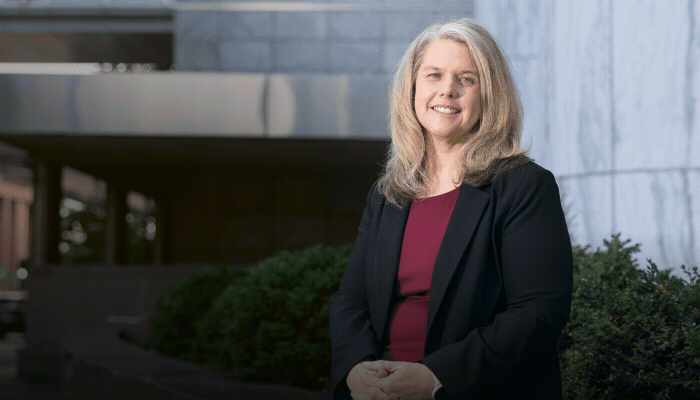Imagine if healthcare technology wasn’t implemented without nurses’ input, but instead was created with them, for them — designed around their expertise, needs and real-world experience.
That’s how Mayo Clinic Chief Nursing Officer Ryannon Frederick is leading change as the multistate healthcare provider implements new solutions, including ambient technology and a generative artificial intelligence tool, to help nurses with their demanding workflows.
“There's no limit to what we can do as nurses,” says Frederick, who is also a registered nurse. “I believe that nurses are the future of healthcare. The untapped expertise and innovation in nurses is one of the biggest opportunities that we have in healthcare, and I would encourage everyone to grasp onto that and leverage it within their organization.”
The newly launched Nurse Virtual Assistant helps nurses access necessary patient information and medical resources so that they spend less time searching through documentation.
“All of this technology is a supplement and a companion to the staff. It's supercharging them so that they can deliver great patient care effectively,” Frederick adds. “None of the technology is making decisions. The nurse is always the reviewer. That's a really important aspect.”
Frederick chatted with HealthTech about involving nurses from a project’s ideation phase, incorporating feedback in real time, and why addressing clinical workflow concerns doesn’t need to happen at the expense of patient outcomes.
Click the banner below to read CDW’s new research report on optimizing modern work.
HEALTHTECH: Before implementing your new workflow solutions, what were some common roadblocks your nursing stakeholders identified? What was prioritized?
FREDERICK: The way that problems had been solved previously had been adding burden to nurses and not making it easier to do what they needed. If it wasn’t easy for the nurse to adopt, you would get inconsistent outcomes. So that was the first barrier: How do you solve challenges differently, and how do you engage nurses in the solution in a completely different way?
We don’t have a good track record in healthcare of bringing in technological solutions that make it easier to do what nurses all join this profession to do, which is to deliver high-quality care. Overcoming that lack of trust is still a barrier. It’s still something that we're working on, and it’s not unique to a single organization. That's nurses across the industry.
We started by sitting down with a group of nurses and asking, “Where are the biggest pain points in your day?” And they were very articulate in identifying those. I think every nurse will tell you that documentation is probably the most dissatisfying thing about their job. Communication was the other. It is hard in healthcare, and the nurse is the one who's with the patient most frequently, so they're often at that very tip of the communication funnel before everything goes to the patient. And finding ways to make it easier to have that balance in staffing and scheduling was the third issue that came up. So those are the ones that we prioritized as big buckets of where to start, all based on what they told us they needed.
READ MORE: Clinical workflow optimization creates better patient outcomes.
HEALTHTECH: How do you ensure user buy-in when you deploy a solution? How can you ensure a solution is actually adopted instead of users trying to find a work-around?
FREDERICK: It starts at the very beginning with nurses on ideating: What are the problems we need to solve? We put them into simulation and watch their workflows, because it's important that we are implementing solutions with them and that we're not adding an extra layer on top of the work they already do. It's something that can be embedded into their current workflow in a way that makes it seamless to execute. From ideation to build to implementation, it’s really about designing a solution based on what the nurses’ workflows are. We are really pushing hard that nurses are innovators. They're co-developers. They are flying the plane; they're not the passenger. When you develop a solution with them, they will feel such pride and ownership because they know that their feedback is being used, and that excites them to rely on a tool.
We're seeing that with our Nurse Virtual Assistant. Nurses noticed that we used their feedback, and I think that really makes the difference when they embrace the tool. I also think it's very clear that we're trying to make it easier for them to do their jobs. That's the goal. We want them to have more time with their patients, less time on screens or keyboards.
HEALTHTECH: What has been the feedback so far with the AI-powered solutions you've implemented? How are you measuring success, and how do you respond to that feedback?
FREDERICK: Healthcare is changing rapidly, and those resources change rapidly, so nurses were sharing with us that they were struggling to find the resources that they needed. They were spending more time digging through the computer than they were delivering care, so that’s where the idea for Nurse Virtual Assistant came in. What if we could surface those resources right into their workflow? We prototyped what we thought would work, and we worked with them to make it better.
Nurse Virtual Assistant also includes a summary of the patient for nurses. When nurses start their shift for inpatients, they go through the chart and look at what happened so that they can prepare. The summary helps nurses reduce the time spent digging through the chart. And the AI is helpful enough to know that one nurse’s needs might be different from another’s. For example, if I'm a nurse in psychiatry, what I need to provide care for my patient on that unit is very different from what I might need if I'm in an intensive care unit. The AI helps create that personalization. So far, we're hearing that this tool saves them time, that it takes some of the burden away and that it helps them communicate with their peers.
We still need more time to measure other outcomes, such as if nurses are spending more time with patients or if the patient experience is better. Are nurses getting breaks? Are they feeling refreshed when they leave? We're looking at a variety of things to try to measure success, but what we're focused on is developing a tool that the nurses love and that they're adopting.
RELATED: Here are some helpful tips for hospitals when implementing Microsoft Dragon Copilot.
HEALTHTECH: How do you strike a balance with solutions that improve both nursing workflow and patient outcomes? What are some ongoing challenges to meet those two aspects?
FREDERICK: The reason I love this question is because that was the constant challenge with the way we used to adopt technology. It was either/or — it either worked for the nurse, or it worked for the patient. It was hard to find something that did both. And that's the change: I don't think it needs to be either/or; I think it's “yes, and.”
I think ambient technology is a great example of that. Ambient focuses on those conversations between a nurse and a patient, and the more the nurse and the patient share, the better the ambient documentation is captured. As a patient, I'm better able to understand what's happening and to participate actively in my care. Family members are telling us they feel comfortable leaving because they know what's going on, and they know their loved one knows what's going on.
Click the banner below to sign up for HealthTech’s weekly newsletter.
HEALTHTECH: How has the technology mindset in nursing changed in the past five years? What are some common beliefs about nursing workflows that can be re-examined?
FREDERICK: Instead of having technology fix a specific patient problem, it's really using technology to empower and embed it in the care team, to supplement and supercharge them. I think another piece is that people are joining healthcare and the nursing profession already using AI and automation in their everyday lives, so they're ready and willing to embrace it. But then you also have individuals who have been in the profession for longer and have seen some of the challenges with technology adoption and are much more skeptical. Balancing both of those as leaders, I think, is really an interesting dynamic. It's important that we as leaders continue to build up the trust that our staff has in these tools.
In healthcare, we have done many things for a long time just because it's the way we've always done them. We have these new technologies that can change those processes, but it’s an opportunity to say, should we be doing that? Does it add value? I think that is actually the first step. We have found in our workflow issues that people want to automate or add AI to solve for. The answer is, actually, we should just stop doing whatever that task is because it doesn't add value to patients or to the care team, and we need to rethink that. That's our opportunity to redesign care delivery altogether.
DISCOVER: How is ambient voice tech revolutionizing healthcare?
HEALTHTECH: What do you find keeps nurses engaged in technological changes?
FREDERICK: In the past, leaders would come in and coach and really manage to get adoption of a new technology going. Now, with both ambient documentation and Nurse Virtual Assistant, we're starting to see our staff, who maybe were not involved with the development of the tools, saying, “This is amazing. I'm going to go back and tell my peers about this. I'm going to take this to unit council and do a demo of this because everybody's going to love this.” Seeing that excitement when it works for them, and then they become part of the change management, part of the spread, part of the adoption – I think that's one piece that is helping to advance some of the work. They love the fact that they're shaping what the next evolution is, and so that's another thing that keeps them engaged.
I think a common misconception that I hear from healthcare leaders is, “We couldn't do that at our site. We couldn't do that at our organization.” And I would tell you, you can. It might not be creating the next ambient tool, but it starts at a very basic place of just talking to your staff and hearing what they need. If documentation is a problem, you can start by looking at the places where you're documenting and reduce some of that redundancy. There are tools that are out there that are embedded in electronic health records already. If you have a partner, you can consider adopting one of those if you think it's the right thing for your team.














